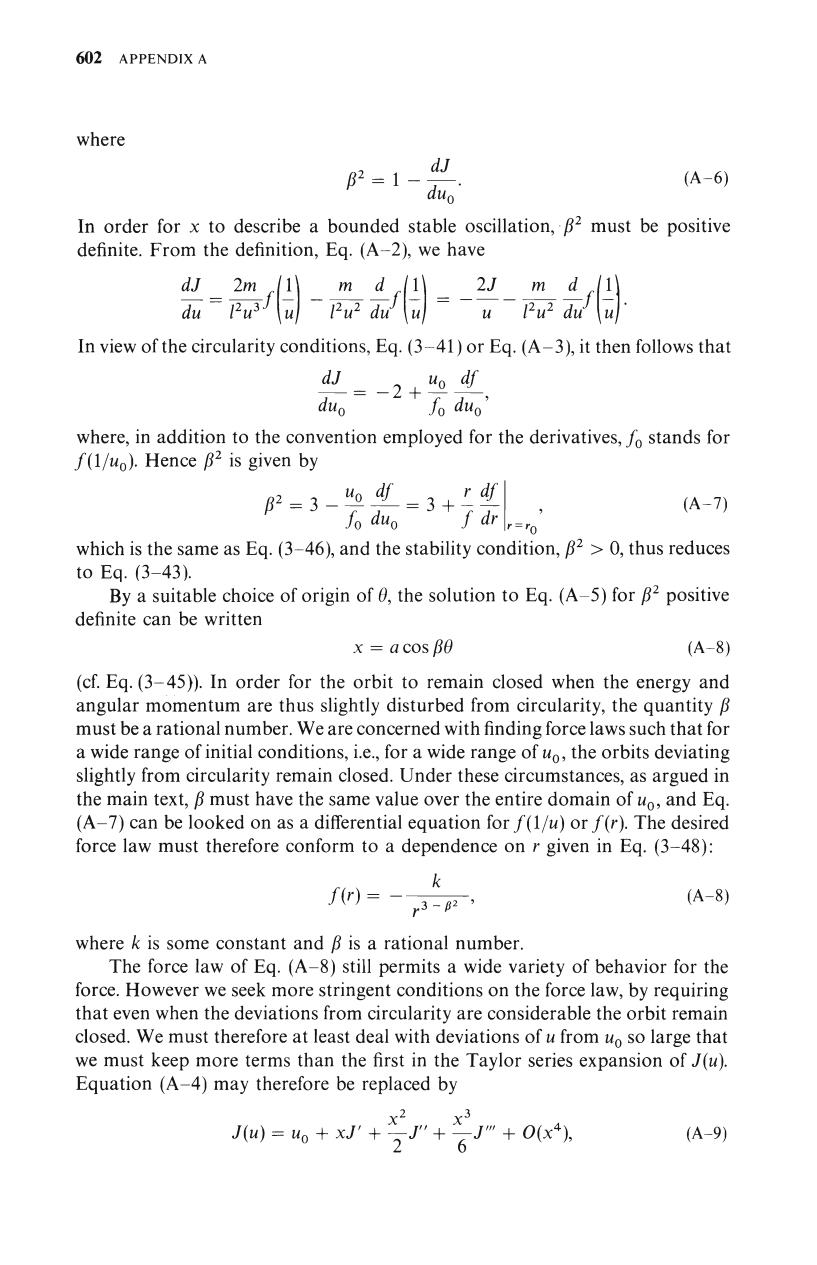正在加载图片...

602 APPENDIX A where B2=1-0 (A-6) duo In order for x to describe a bounded stable oscillation,B2 must be positive definite.From the definition,Eq.(A-2),we have dJ 2 2J m du Pu u In view of the circularity conditions,Eq.(3-41)or Eq.(A-3),it then follows that d=-2+ uo df duo fo duo where,in addition to the convention employed for the derivatives,fo stands for f(1/uo).Hence B2 is given by g=3-=3+ r df ∫dr=ro (A-7) fo duo which is the same as Eq.(3-46),and the stability condition,B2>0,thus reduces toEq.(3-43). By a suitable choice of origin of 0,the solution to Eq.(A-5)for B2 positive definite can be written x=acosβ0 (A-8) (cf.Eq.(3-45)).In order for the orbit to remain closed when the energy and angular momentum are thus slightly disturbed from circularity,the quantity B must be a rational number.We are concerned with finding force laws such that for a wide range of initial conditions,i.e.,for a wide range of uo,the orbits deviating slightly from circularity remain closed.Under these circumstances,as argued in the main text,B must have the same value over the entire domain of wo,and Eq. (A-7)can be looked on as a differential equation for f(1/u)or f(r).The desired force law must therefore conform to a dependence on r given in Eq.(3-48): k f(r)=- r3-B2, (A-8) where k is some constant and B is a rational number. The force law of Eq.(A-8)still permits a wide variety of behavior for the force.However we seek more stringent conditions on the force law,by requiring that even when the deviations from circularity are considerable the orbit remain closed.We must therefore at least deal with deviations of u from uo so large that we must keep more terms than the first in the Taylor series expansion of J(u). Equation (A-4)may therefore be replaced by J(u)=uo +xJ'+ 2 2" 6J”+0x4, (A-9)602 APPENDIX A where In order for x to describe a bounded stable oscillation, .P2 must be positive definite. From the definition, Eq. (A-2), we have In view of the circularity conditions, Eq. (3-41) or Eq. (A-3), it then follows that where, in addition to the convention empIoyed for the derivatives, fo stands for f (llu,). Hence P2 is given by which is the same as Eq. (3-46), and the stability condition, P2 > 0, thus reduces to Eq. (3-43). By a suitable choice of origin of 6, the solution to Eq. (A-5) for P2 positive definite can be written (cf. Eq. (3-45)). In order for the orbit to remain closed when the energy and angular momentum are thus slightly disturbed from circularity, the quantity P must be a rational number. We are concerned with finding force laws such that for a wide range of initial conditions, i.e., for a wide range of uo, the orbits deviating slightly from circularity remain closed. Under these circumstances, as argued in the main text, fl must have the same value over the entire domain of u,, and Eq. (A-7) can be looked on as a differential equation for f (llu) or f (r). The desired force law must therefore conform to a dependence on r given in Eq. (3-48): where k is some constant and fi is a rational number. The force law of Eq. (A-8) still permits a wide variety of behavior for the force. However we seek more stringent conditions on the force law, by requiring that even when the deviations from circularity are considerable the orbit remain closed. We must therefore at least deal with deviations of u from uo so large that we must keep more terms than the first in the Taylor series expansion of J(u). Equation (A-4) may therefore be replaced by